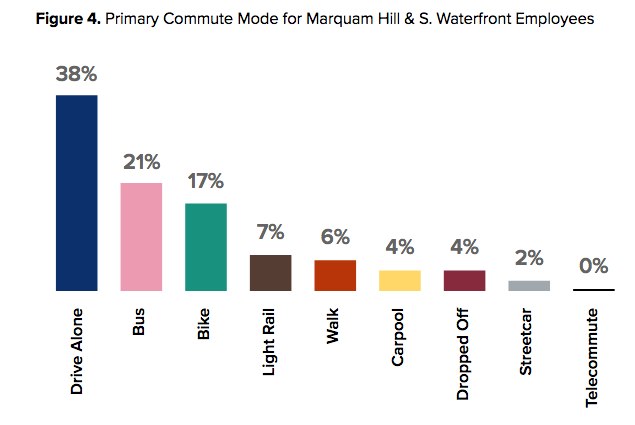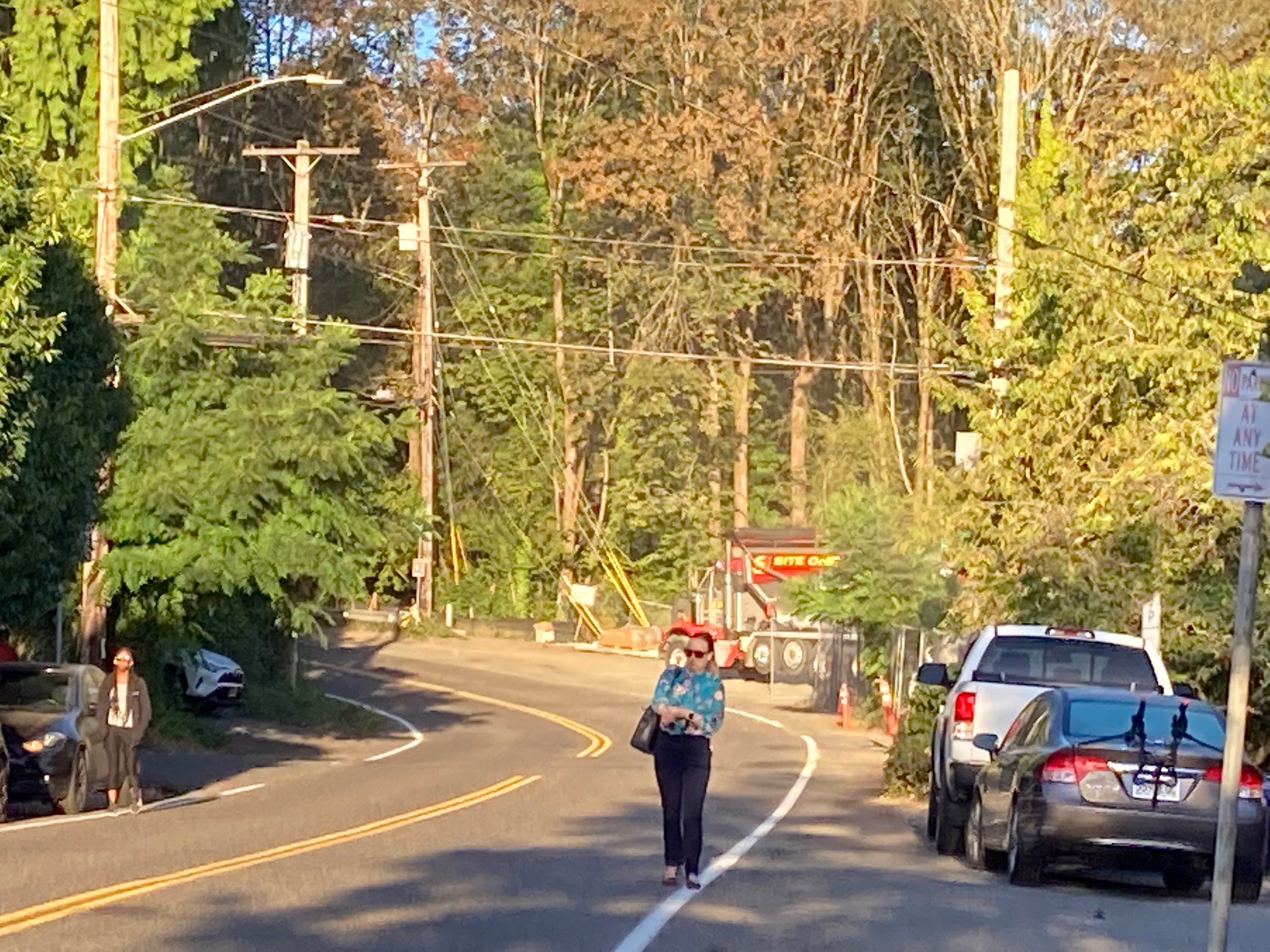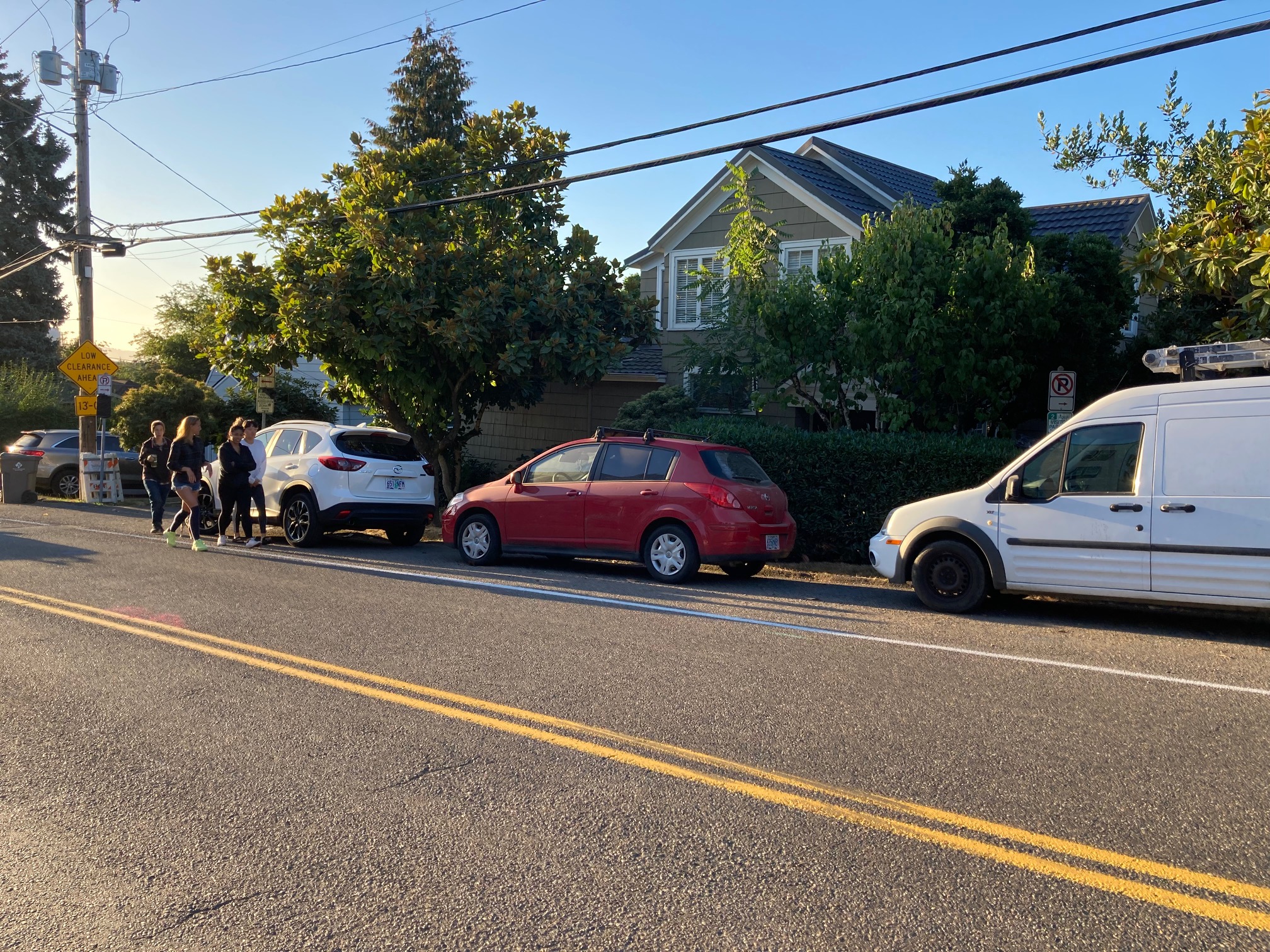
I already had the story written in my head. All I needed to do was make an early morning run over to OHSU for some more photos and I was good to go.
Another southwest development going in without a sidewalk—43 units this time! Area stakeholders not happy. I know this story like the back of my hand. And I have walked the road, SW Gibbs St, a million times, there was really no need for another visit.
But I sure am glad I went anyway! When I got there and was actually standing on Gibbs, the story I thought I was going to write melted away. In its place is a fuller tale about how the city’s largest employer, the surrounding neighborhood, and private developers have done their parts to make Portland a greener city. And how the city needs to keep up its end of the bargain.


The university
My new story begins with the Oregon Health & Sciences University (OHSU). OHSU is Portland’s largest employer, and the premier hospital and biomedical research facility in the state. It’s also on a steep hill and very constrained for space. In the face of the university’s rapid growth in the early 2000s, the city began capping and regulating on-campus parking.
With parking limited, and rapid growth underway, OHSU and the adjacent Homestead neighborhood became a test case for the city’s growth, transportation and parking policies. The results look very good, although the ride has been bumpy.
Michael Harrison, the director of local government and neighborhood relations for OHSU, told me the university has only one parking spot for every three employees. And the resulting mode-share is enviable: 30% of OHSU employees use public transit to get to work, 17% bike, and 6% walk (these are pre-covid numbers).
Moreover, they are in the process of planning 500 locked and covered bike stalls on the Marquam Hill campus to comply with the city’s new bike parking regulations.
The neighborhood
The restricted parking puts pressure on the surrounding neighborhood. It is difficult to find street parking, and in the past some neighbors have rented parking spots on their properties to OHSU employees (the city has since curtailed that). Although OHSU is well-served by public transportation on the approach from the east, areas to the west are poorly served in terms of both public and active transportation.
This brings us to SW Gibbs St.


The only access to the university from neighborhoods west of campus is along SW Fairmount Blvd and down Marquam Hill Rd to Gibbs St. Most streets in southwest Portland don’t have sidewalks or bike lanes, this route is no exception. (Gibbs has a sidewalk from the OHSU campus to 11th Ave, the boundary of the white background on map above.) Nevertheless, people bike and walk to OHSU along this route. A walk down Marquam Hill Rd requires the pedestrian to zig-zag across the street three times in search of a walkable shoulder.
About a decade ago, I lost my footing on the edge of the asphalt on Marquam Hill Rd, turned an ankle and fell. The ankle was so swollen I couldn’t walk on it for a week. This is not a safe route. Not to mention that these are narrow roads with a decent amount of car traffic, traveling at about 30 mph.
The development
Right across the street from where I twisted my ankle, a new 43-unit apartment building is being built.
Neighborhood associations take a keen interest in development, partly because it is the main avenue to getting active transportation improvements in southwest Portland. The Homestead Neighborhood Association is unhappy because the Development Review department within the Portland Bureau of Transportation (PBOT) is not allowing the private developer to put in a sidewalk on Gibbs. You read it right, “not allowing.” This is a headscratcher, because all the stakeholders want a sidewalk—the developer, the NA, even OHSU has worked for years with neighbors and the city to improve active transportation infrastructure in the area.
Speaking generally, “It is critical that our employees and students have safe ways to bike and walk to our campus,” OHSU’s Michael Harrison told BikePortland.
Homestead NA President Ed Fischer said, “All I can figure is that they have blinders on, they are not looking at this as a system.”
The developer explained in a public meeting that,
PBOT has pushed back on us providing a sidewalk along our frontage on SW Gibbs. However, we are proposing a wide shoulder to accommodate pedestrian travel on our property… A safe sidewalk along Gibbs will help not only existing neighbors, but our future tenants as well.
I visited the site yesterday morning and spoke with a Senior Superintendent at Edge Development, Patrick Beaston. He told me that the new development was “bike-friendly” and that the building will have 1.2 bike racks per person, charging stations and storage, including for e-bikes and tandems.
The shoulder will be five feet wide and bikeable, he explained, and the shoulder at their other development down the hill on Gibbs (at 12th Ave), would be seven feet wide.
The street becomes very narrow in front of the site. For cycling, a wide shoulder might be the best improvement to navigate this steep hill. Pedestrians would probably be better off with a curbed sidewalk. Neither group will be well-served if drivers use the shoulder to illegally park their cars, although a five foot shoulder might be narrow enough to discourage car parking.
Another neighborhood association-Development Review skirmish in southwest Portland. These will probably grow in intensity as the city implements congestion pricing and raises the price of downtown street parking without providing or requiring adequate alternatives to driving in this quadrant of the city.
The city
Development Review can point to lack of stormwater facilities as a reason for not requiring developers to build sidewalks, but in this case stormwater doesn’t seem to be the issue. Allowing or requiring cement sidewalks along the frontage of these two new developments would be a significant addition toward extending the existing Gibbs sidewalk to 11th through 14th Avenues.
I reached out to PBOT’s Interim Director of Communications, Hannah Schafer, for clarification about the sidewalk decision, she replied:
We required a 6-foot shoulder widening on SW Gibbs for the frontage of this development. Unfortunately, due to significant storm water, soil, and topographical challenges on the hill we couldn’t require a standard curb and sidewalk improvement. Shoulder widening is a common requirement for projects in Southwest Portland that have similar constraints.
This is an unsatisfying response given the area of a sidewalk would be tiny relative to the large footprint of the building, and stormwater runoff from the building will be “appropriately managed via collection and discharge to a combined sewer main in SW Gibbs,” according to city staff analysis presented to the Hearings Officer.
But there you have it, another neighborhood association-Development Review skirmish in southwest Portland. These will probably grow in intensity as the city implements congestion pricing and raises the price of downtown street parking without providing or requiring adequate alternatives to driving in this quadrant of the city.

Lisa Caballero has lived in SW Portland for 20 years. She is on the Transportation Committee of her neighborhood association, the Southwest Hills Residential League (SWHRL) and can be reached at lisacaballero853@gmail.com.
"come" - Google News
September 10, 2022 at 01:00AM
https://ift.tt/WMDxrI7
A dispatch from SW Gibbs, where development doesn’t come with sidewalks - BikePortland
"come" - Google News
https://ift.tt/cmTV5zU
Shoes Man Tutorial
Pos News Update
Meme Update
Korean Entertainment News
Japan News Update
Bagikan Berita Ini















0 Response to "A dispatch from SW Gibbs, where development doesn’t come with sidewalks - BikePortland"
Post a Comment